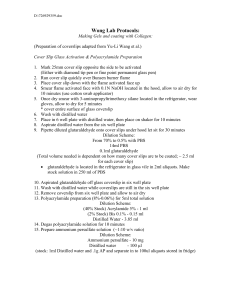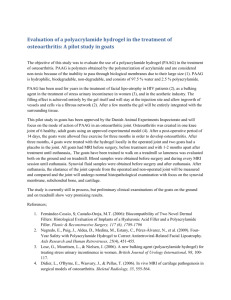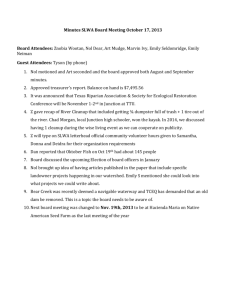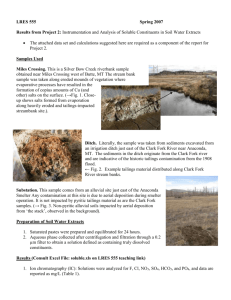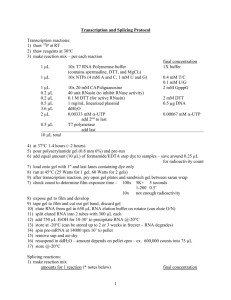Anionic Polyacrylamide
advertisement
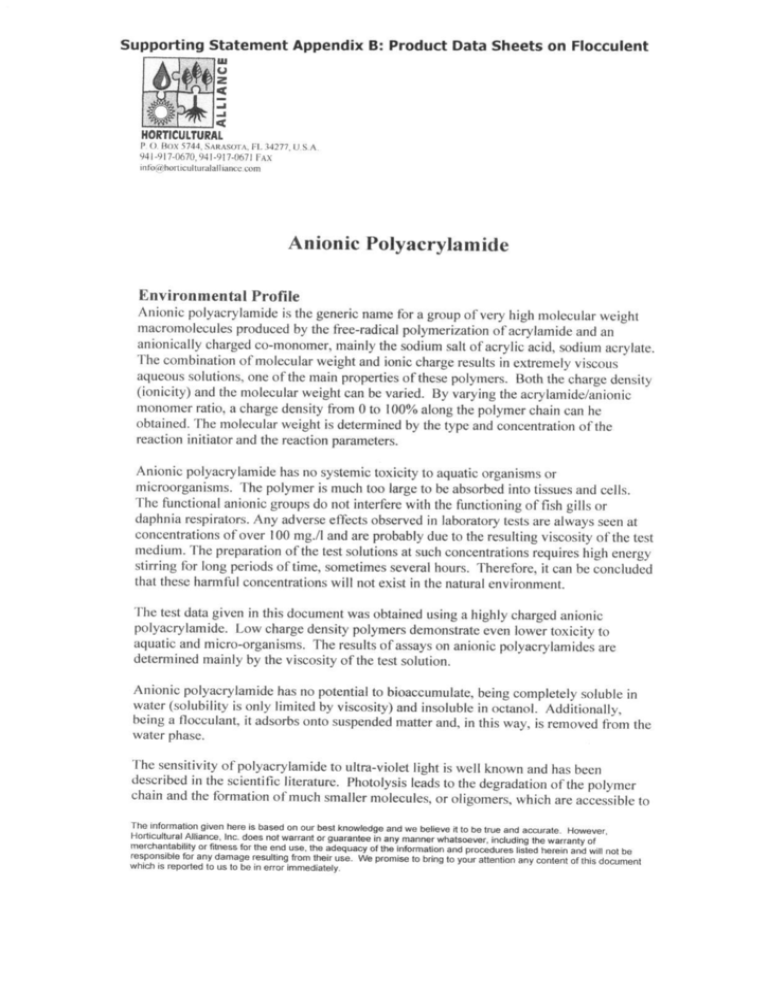
SupportingStatementAppendixB: ProductDataSheetson Flocculent
atl
(J
z
s
Hotftcut?uR
r.
I () lJOx5744.
S^(Asor^Fl.:t!277,Lrs
941917,0670.
94t-917-0671
t;^x
inroa.thortrullu.uldlnncc
{n
AnionicPolyacrylamide
Environmental
Profile
Anionic polyacrylamide
is thegenericnamefbr a groupofvery highmolecularweight
macromolecules
producedby the liee-radicalpolymerization
of acrylamideandan
anionicallychargedco-inonomer,
mainlythe sodiumsaltofacrylic acid,sodium&crylate.
Thecombinationofmolecularweightandioniccha.gercsultsin extremelyviscous
aqueoussolutions,oneofthe mainproperties
ofthesepolymers.Both thechargedcnsrry
(ionicity)andthe molecularweightcanbe varied. By varyingtheacrylamide/anionic
monomerntio! a chargedensityliom 0 to 100%alongthepolymerchaincanhe
oblained.'fhemolecularweightis determincd
by thetypeandconcentration
ofthe
reactioninitialorandthe reactionparameters.
Anionic polyacrylamide
hasno syst€mictoxicityto aquaticorganisms
or
microorganisms.
The polymeris muchtoo largeto beabsorbed
into tissuesandcells.
Thc functionalanionicgroupsdo not interf€rewith the functioningo1.fishgills or
daphniarespirators.
Any adv€rseeffectsobservedin laboratorytestsarealwaysseenat
conc€ntrations
ofover 100mg./landareprobablydueto theresultingviscosityolthe test
medium.Thepreparation
ofthe testsoiutionsat suchconcentrations
requireshighcnergy
stirfingfor longperiodsoftime, sometimes
severalhours.Therefore.lt canbe concluoeo
thal thescharmfulconcentrations
will not existin the natumlenvironment.
Thetestdatagivenin this documentwasobtainedusinga highlychargedanionic
polyacrylamide.Low chargedensitypolymeNdemonstr&te
evenlowertoxicityto
dqualicandmicro-organismr.
fhe results
ofassays
on aniunicpollacrylamide,
are
determined
mainlyby theviscosilyofthe testsolution.
Anionic polyacrylamide
hasno potentialto bioaccumulate,
beingcompletelysolublein
water(solubilityis only limitedby viscosity)andjrsolublein octanol.Additionallv.
beinga flocculant,it adsorbsontos[spendedmatterand.in this \ray, is removedl.romthe
waterphasc,
'fhe
sensitivityofpolyacrylamideto ultrd-violetlight is well knownandhasbeen
describedin thc soientificliteraru.e.photolysisl€adsto thedegradation
ofthe polymcr
chainandthe formationofmuch smallermolecules,
or oligomirs,whichareacces.sible
to
Thernfomarcn g'ren heb ts bss€don our b65lrnow'€dg6andwe bet€@rl ro b6 ttuc ,nd
,@rdle. Heeve,
Inc do€snotw.rarn d 9uar.nt6em3nynannq whar3o6c,,rlctLdinathew.rsntv6f
narGanraonryor noE\s to, the 6.d use lh€ adoqu,cvol the inlo_a o, andproedrres hiod n",..n
ani *rr norr"
,es!ons,br6
roranrdamase
esut.nqlron rhonuse.viepromise
to orinsroy,iu,an""r"; ,;t;;i;;i
whi.h is epori6dlo us to be 'n €rro.moed,alsrv
;iihi; ;;;;;;"r
Honcur.ru[
P o 4 0 x 5 7 , 1 ,S
1ARASdA.FI-1.1277.t,SA
941'9i7-0670.9.1l-9l70671rA\
'nlitalho.lrcullffalalliana od
microbialattack.A recentstudydemonstrated
thatphotolysisfollowedby aerobicol
anacrobio
treatmentresultedin eflicientmineralization
ofthe f,olymer.This stud),
providesevidencethatacrylamjdepolymershavethe potentiaito be naturallybroken
down andbiodegraded
anddo not persistor accumulatc
in theenvironment.
Two fccentlyconducted,
majorenvironmental
risk assessments
concludedthataniontc
polyacrylamide
doesnot represent
a dangerto theenvironment.SI'OWA, the
Netherlands
Waste-Water
Authoritycalculated
a PEC,4\iEC
ratiomuchlowerrhanI for
organicpolyelectrolytes
in generalandconcludedthat theirusein waste-water
trealment
doesnot constitutea risk to the natulalenvironment.AnotherreviewofpolyelectrolFes
by Environmenl
Agencyofthe tJnitedKingdomconcludedthatanionicpolyacrylamide,
like the orher
or8anicpolyelectrolytes,
is not a priority for the sensingofenvircnmentalqualiry
(EQS)andoflittle cnvironmenhlconcem.
standards
Chemicalldentity
Chemicalnamc:2-propencic
acid,sodiurnsaltpolymorwith 2-propenamide
f)the. names:Copolymerofacrylamideandaorylicacid,sodiumsaltAcrylamide,sodium
acrylatecopolymer
- 02 - 3
CAS number:25085
PhysicalChemicalPropefties
Molecularweight:greaterthan 1,000,000
Daltons,usuallygreaterthan5,000,000
Solubility:totallymisciblein water,insolublein nectanolandothersolvents
pH: 6 to 8 in solut;onal 5g/L
Apparentdensity;|.08
Meltingpoinl:> l50C
Aquatic Toxicology
A. Toxicity
to fish
LC50/Brachydanio
rerio/96hrs.
LCo/ Brachydaniorerio/96hrs.
Il. foxicity to daphnia
EC50/Dapbnia
Magn:r,/48
hrs
C. Toxicity to algae
liC50/Chlorellavulgaris/96hrs
No Obscrvedgffect Concentmtion
D. Toxicityto bacteria
357 mg/l
178mg/l
212 mgll
1,000mg/l
708mg/l
giwn hee is basedon ow bestknowledge
The into.malion
ande beti€6 to be truelnd a@Ete. Ho!€wr,
Honicullural
Allian6, lnc.d@s @l waoantor guaranteein any mannerwhatsoew.,Including
ihe w.ftnly of
me.chanlabililyor litness lor lhe end use the adequacyof the inlomation and p.oceduEs tisted h6ein ad wil no{ be
responsibreror any damsge resoling fom th6ir use. \4b promls€lo bnng to your attsuo. any conlent ot lhts do@ment
whicn is reponed b us io b€ in 610. immodiatety.
||l
(,
z
(
lroRlrcut
tutar
P O B o x5 7 , 1 , 1 . S ^ R a sf Ld3r . l l 7 7 . l JS A
94 917,0670,941-9t7-0671
F^\
'nJa!!honicultumlalli&c.
$n
ECIO/Pseudomonas
putida/18hrs.
l.lc50/Pseudomonas
putidtl 8 hrs.
12'7mg/l
892mg/l
ENVIRONMENTAL DATA
A. Itiorccumulation
Anionic polyacrylamide
beinglotally solublein waterand insolublein solventshasa
very low n-octanol/water
partitioncoefficient(POE),andtbr all practicalpurposes:
log Pow= 0
Thus,the potentialfor anionicpolyacrylamide
to bioaccumulate
is zero.
B. Abiotic degradation(pbotolysis)
Anionic polyacrylamide
is sensitileto ultra-violetlight,whichbreaksdownthe polymer
backboneinto oligomers.A positivecorrelationis observedbetweenthe lengthof
erpositionto light andthe degreeofbreakdown(i.e-,rcductionin molecularweight).
C. Biodegradatiotr
Non-degraded
anionicpolyacrylamide
hasbeenshownto he recalcitrant
to microbial
degradation.This is probablyrelatedto theextremelyhighmolecularweight,which
fendersmiorobialattackvery difficult. However,oncethe polymerhasbeendegraded
throuShphotolysis(;.e.,the actionofUV light),andthemacromolecule
brokendowr,
into oligomers.it becomes
bioavailable
and is biomineralized.
A studyusingC14 labeling,designedto evaluatethepotentialtobiodegmde
anionic
polyacrylamide
demonstmted
thata combinationofphotolysisandmicrobialattackleads
to naturalattenuation
ofthesepolymers.After 48 hoursofexposureto UV, the
'l
oligomersMW < 3.O0ODaltons)increased
from under2% to 80o/o. his enabledafter
38 daysincubationlbr thepolymerto be biodegraded
at least2970aerobicallyandl7%o
anaerobically.
D. ResidualMonomers
We takesthe utmoslcareto ensurethatthc constituent
monomeN(in thiscaseacrylamide
and sodiumaorylate)areascompletelyreactedas possibleduringpolymerization.
l]owever,technicallyunavoidable
tracescananddo remainin the finishedpolymer,
especiallyin powderproducts.For standardproducls.our qualityassurance
guarantees
that polyacrylamides
containlessthan0-lo%w/w (< 1000ppm)ofresidualacrylamide
monomerand lessthan0.5%w/w (< 5000ppm)or residualsodiumacrylate.In fact,on
average,there;s about0.04%(400ppm)ofresidualacrylamideandabout0.2%(2,000
ppm) ofresidualsodiumacrylate.
The inlormalion giwn here G bas€d on our best kndtedgo and w€ betieE it lo be true and a@€le However.
Horticultu.al
Allian@,hc. d@s nol w.r€nl or quaranteein.ny mannerwhatsew., inclldingthe warsnly ot
nerchanlability or frhosd lor lhe end use, lhe adequacyof tne intumaiion a.d pro@dur66risrodherein 6nd wil not be
@$onsibletorany damageEsullinqlromth€iruse Urepomise to bdnqto yolratlentis any contentofthisdocumeni
whichis.€p.rled lo us to be in eiior idhddiatoty.
|lr
(,
2
rl
Horflcullutlr
P.O Box5?44_
Sesora_ FL3427?.
U.S.A.
941-91
7.1X70.
941,9t7-0671
F^x
info@nonicutlunlrlli!@.@n
Botbacrylamideandsodiumacrylatearereadilybiodegradable
underaerobicconditions
at over90oloin 28 days. Ev€nat opc.atingdosesashighas50 mg/l,theresidual
monomers
releas€dintotheenviromentwill neverreachconoentmtions
thatcould
constitutea dsk to theaquaticlife. Theirhighbiodegradability
negates
thepossibilityof
aocumulation
in th9naturalenvironment.
Thaintomellongivs. h€E i! baed on ourbestkno*r€dg€6ndw€ botieEitto b€hro rnd acdrrts. HoMw.,
HoftcultvralAllilnce,lnc,d€ notw.m.t or guannt € in anyn3nB. wh.bo€vsr,inctudingtF w&anly of
mrcnanbbllttyor filnos for ihe 6ndus€,the sdequtcyof tl6 infomarionandp.o.adure3rilrt€dha€in andwi[ notb€
€sponsrbbtor anydamag€|@hing fom $.rr !66. u/b pmmie ro bnngto yos 3{sillon rny conEntotni! do@mont
whidris Eportsdlo us to b€ in €Eo.i.nh6dl.!oly.
Goldcrest
l9h,.n.iFP,(&.nfud'tdhtdsl'b'
MATERIAL SA}'ETYDATA SIIEET
'1.
IDENTIFICATION
OF THE PRODUCTAND COMPANY
ProductName:
POLYGOLD A527
Goldffes1ChemicalsL1d
llodBoih DusincssPa.k
CreatClille Road
SoulhYorkshir€,s75 3SP
ling'and
Ljmeryenc)
t€lcpho.cnumbe.:
2.
COMPOSITIONNNFORIVATION
ON INGREDIENTS
Chemicatcomposilion:
Anionicacrylamidecopolymef.
Drrurroussobshnce
3.
01226720Im
9/oPr€s.rt
g!c$!!is!h!
Riik Phrrs.s
HAZARDSIDENTIFICATION
Basedonan analys;so I thc corponenrsthe matdialis not thoughlto presenlanymljorh@lth hazards.parlicularl'
whq hsdled corslly with apprcprislcPPII.
l his producrwh€nwet renderssurtiicesextremel'slipper).
lhis producldo.s not burnreadily,bu1.as lvilh mary organicpowders.l'lammablc
dusl cloudsnay be lbrmedin air.
4.
FIRSTAIDMEASURES
Eyeconlact:
SLinconlacl:
lngcstion:
Inhalalnrn:
5.
r;nscimmL{ialclyunderrunning$ aterfor a1le3st| 5 minules-Itirrilolion p€Ais1sseek
medicaledv;ce.
$ ashwith pl.nly of soapandsalcr.
do not inducelom;ling. lt@nscious.inseout mouthwith wa(erandgi\,e*atcr to drink,
rcpcatin8everyl0ftinutes. Serkmedioalltcniion.
rcnolc io lresha;r. Sek medicalatenlionil an) ill cfl.rrs pe6isr.
FIREFIGHTING
MEASURES
Flxlingu;shiismedia:
Ifinvolved in a llrs
Dltc prinlcd:20/04/05
suitable,
carbondioxide,fom. d.y cbemical.in preference
to warcrspay.
unsuilablcwe.arself@ntainedbreathingappamlus.Conrbusrion
may resullin lbmation ofOxides
ofCarbon.
hsuc: I
Ptuducr POLYGOLD,4527
Dateof issue;3/9/03
Rcfnumb.r: |YGDA5T
ACCIDENTAL
RELEASE
MEASURES
ObseNem)waminglabelsontheconta;ner.
WearSloves
andeyeprulcc,tion.
Materi:J
wilt p.oduce
stipp€ry
surfaccs
whenwel. Smallrcsidues
shooldbctho.ouehly
hosedawaywilhsarer.
Contain
an) spilledmaterial
immediately
andplaceinrocontainers
fof disposal
accordingto
locslregularions.
Do
nolallowpruduct
to enlerwaterqrurses-
7.
HANDLING
ANDSTORAGE
Handl;ng:
us in w€llventihtcd dcas. As wilh nanyor8anicpowdenflamnabledusrcloudsmay
be fo.mcd. Avoid ffealingdustmd keepa$ay from sources
of ignnion. when hddling
lhis prcduc1obser!e good steda.dsof industial hygi€ne10aroid swallowing.inhating
dustandeyc andsk;nconlact.Il is slwaysadvisableto $csrhand p.olectionwhet
Avoid exlrenesof lcmp€rature.Prolccli-rcmwet nd huftid conditions.
8-
EXPOSURE
CONTROLS
/ PERSONAL
PROTECTION
ensure
wo.kplacc
is s€ll venrila!€d
Handr impervioussloves
Evc:
9.
gogsl€r
PHYSICAL
ANDCHEMICAL
PROPERTIES
trrplosivepmperties:
Odourl
Oiidlsing prop.fiies:
pH:
Boiling pointrNngel
Rehtiv. density:
Melting poiDt/rlngel
N/A
Bulkdensity:
appox 0.75 g/cmr
Fl{sh point:
N/A
Solubility:
Flflnmrbility:
As witi manyorSanic
powdcGfldnmabledust
cloudsma) be fomed.
waler- formsvisoussolution
lat othtr solvents-
Prnlition co-efiicient
'10. STABILITYAND
REACTIVITY
wet and humidconditions.Avoid extremesoflemperalure
Ilazardousdecomposilion
products:
1't.
ombustion may resih in lbmalion ofoxidesofcarbon
TOXICOLOGICAL
INFORMATION
> 2000mg/k8(ra0 (basedon analysisofomponenls)
may causeslightlransicntiditaiion.
nol likely to oauseskinir.ilalion
Acut€oral loxioiry l-D50i
Eyc ir.ilation:
D!r. prib!edi20/04/05
tssue:I
Producr:POLYGOLDA527
Refnumber:
PYODAsT
ECOLOGICAL
INFORMATION
Acur€loxicity to fish:
Lc50> 350 ng/l (96hrrebrafish).
Acutetoxicity to daphnia:EC50> ? 12mg/l (48 hr).
1 3 . DISPOSAL
CONSIDERATIONS
Disposeof in ac.ordanccwith localandnationalregulalions.Conrain€rs
canberranspon€d
/ deliveredby a
tegisl€r€dwaslecarier 1olocalrecyclingfacilities.
14.
TRANSPORT
INFORMATTON
This producl ;s nol classifi€d for tmnspon undef the EC Diretives ard th€ UK Classificarion, Packagingand
LabellingR€gulations.
PropefshippinSname:
UN numb€l
Hazird class:
Packinggroup:
REGULATORYINFORMATION
EINECS NUMBERST
All componentsofthis product ar€ inclqded in th€ EINECS inventory in complian€ uith
Di.eclive 67|548/EEC and its d$endmenrsUs€rsupplylab€ls:
Symbol:
Classification:
Risk phmses:
Safety phras€sr
'|6.
Non€
Non€
None
None
OTHERINFORMATION
NOTD: ftre infonnalionb@in k povidel fo.1hegndal gtidsn@of es1om6 md ir 6npli.n€ wiin dE leflnsof cunenr
her11h
andsafetylegklatio, Nothing@tained hercinshall@nsrirut€ey sdanr], guarsntee
or repmartariond 10lie
qual'1y.fiin* o. pDpdriesol thep.oduct.
Daleprinlcd:20l04/05
lssue:1
Product:POLYGOLIJ/\527
Dateofissue:3/9/03
Refnumbn pycDAsT
